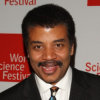Neil deGrasse Tyson

Neil deGrasse Tyson
Neil deGrasse Tysonis an American astrophysicist, cosmologist, author, and science communicator. Since 1996, he has been the Frederick P. Rose Director of the Hayden Planetarium at the Rose Center for Earth and Space in New York City. The center is part of the American Museum of Natural History, where Tyson founded the Department of Astrophysics in 1997 and has been a research associate in the department since 2003...
NationalityAmerican
ProfessionScientist
Date of Birth5 October 1958
CountryUnited States of America
Science is a cooperative enterprise spanning the generations. It's the passing of a torch from teacher to student to teacher. A community of minds, reaching back to antiquity and forward to the stars.
I didn't even know there were stars to look at to not see. If you don't know that they're there, you don't know that you're missing them.
For your own safety, do not ever tell an astrophysicist, I hope all your stars are twinkling.
In astrophysics, we care about how matter, motion and energy manifest in objects and phenomenon in the universe. Stars are born. They live out their lives. They die. Some of the ones that die explode. Our sun will not be one of those, but it will die. And it'll take Earth with us. So we make sure we have other destinations in mind when that happens. And I've got it on my calendar.
In the movie, the stars above the ship bear no correspondence to any constellations in a real sky. Worse yet, while the heroine bobs... we are treated to her view of this Hollywood sky-one where the stars on the right half of the scene trace the mirror image of the stars in the left half. How lazy can you get?
There are as many atoms in each molecule of your DNA as there are stars in the typical galaxy. This is true for dogs, and bears, and every living thing. We are, each of us, a little universe.
Stars die and reborn […] They get so hot that the nuclei of the atoms fuse together deep within them to make the oxygen we breathe, the carbon in our muscles, the calcium in our bones, the iron in our blood. All was cooked in the fiery hearts of long vanished stars. … The cosmos is also within us. We're made of star stuff. We are a way for the cosmos to know itself.
Trillions of years into the future, when all stars are gone...all parts of the cosmos will cool to the same temperature as the ever-cooling background. At that time, space travel will no longer provide refuge because even Hell will have frozen over. We may then declare that the universe has died-not with a bang, but with a whimper.
Here's the problem, when you're stargazing on a mountain top you are partially oxygen-deprived and you're in command of million dollars worth of hardware. So as much as I would like to sip wine under the stars, it's contraindicated in the instructions on operating telescopes.
We only recently figured out the origin of our own moon. And we have some idea of how the Sun and Earth formed, but that's only because modern telescopes empower us to see other stars and planets freshly hatched within gas clouds across the galaxy. As for the origin of life itself, the transition from inanimate molecules to what any of us would call life remains one of the great frontiers of biology.
I never got into 'Star Wars.' Maybe because they made no attempt to portray real physics. At all.
To achieve this density of a neutron star at home, just cram a herd of 50 million elephants into the volume of a thimble.
The iron from that meteorite and the iron from your blood have common origin in the core of a star.
We can trace the elements. They were forged in the centers of high-mass stars that went unstable at the ends of their lives, they exploded, scattered their enriched contents across the galaxy, sprinkled into gas clouds that then collapsed and formed stars and planets and life.